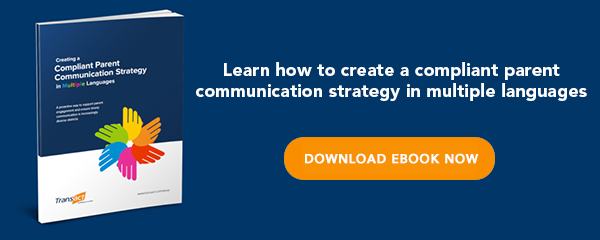Effective parent-teacher communication is proven to positively impact academic and emotional outcomes for students. Evidence shows that students with involved families are more engaged in the classroom and more likely to succeed academically.
School districts recognize the importance of strong parent and family engagement; however, hours of availability, technology, language barriers, and cultural differences can impede the communication between parents and teachers, and make it difficult to form relationships. As an added challenge, teachers and administrators have over 200 places in federal law where they are required to notify or contact a parent, creating an administrative and bureaucratic burden for both parents and teachers on top of regular, day-to-day challenges.
Fortunately, edtech solutions can help eliminate many of the parent-teacher communication challenges that K12 leaders experience, and ultimately increase the authenticity and effectiveness of parent engagement across the school district.
Book a demo to learn more about our K-12 software solution, ParentNotices:
Common Obstacles to Effective Parent-Teacher Communication
Below, we examine some of the most common obstacles to strong parent and family engagement.
Limited School Resources
School administrators often have very little capacity to compliantly manage multilingual communication processes because there is so much complexity with parent engagement and translation requirements under federal law.
It is extremely difficult for teachers and administrators to find the time to obtain the legal expertise needed to guarantee compliant communications amid the core requirement to provide instruction and administer a school or district. What’s more, it can prove even more challenging to interpret changes to education laws and regulations when new guidance documents are released.
Language and Cultural Differences
With schools becoming increasingly diverse, more than half of U.S. teachers are concerned about potential language barriers with English learner (EL) students. Culture and language differences can create communication pitfalls in and out of the classroom.
Communication pitfalls can prove problematic, not only because they impact student outcomes but also because school districts have a legal obligation to communicate in a language parents understand. Failure to comply with legally required communication mandates can result in a citation or finding for noncompliance during a monitoring visit with the resulting requirement of developing a corrective action plan to address these noncompliance issues.
Lack of Parental Understanding
A recent survey of the top obstacles to strong parent and family engagement cited not understanding the importance of parent involvement as the primary issue. Many parents and families believe their involvement is no longer necessary after students reach a certain age. Some may also feel they lack the knowledge and skills to help with their child’s education.
Other obstacles come into play as well, such as mutual misconceptions between teachers and parents, skewed perceptions about the education system, and parents often having limited time to be involved. Technology plays a significant role by removing obstacles and enabling more effective communication.
Eliminating Communication Obstacles with Technology
Technology removes the burden of trying to manage parent-teacher communication requirements internally and allows in-house resources to be more readily available for other tasks. Utilizing a parent engagement compliance solution such as TransACT ParentNotices also enables school districts to:
- Communicate with parents in their preferred language on their mobile device
- Increase parent engagement and administrator transparency
- Access legally required parent notices in multiple languages
- Avoid potential state or federal audit citations for noncompliance
- Generate cost savings by increasing the availability of internal resources
- Reduce the need for costly translation services for school forms
By taking a proactive approach and identifying ways to eliminate any obstacles standing in the way, school districts can communicate with parents more effectively, bridging the gap between school and home to promote greater education and stronger parent and family engagement. Learn the best practices for setting up a comprehensive, compliant parent-teacher communication strategy in multiple languages.
Book a demo to learn more about our K-12 software solution, ParentNotices:




